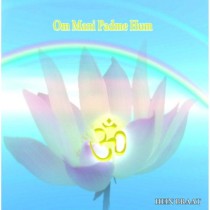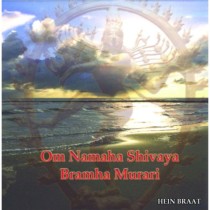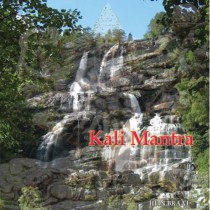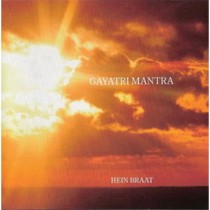Hein Braat
Hein Braat is the most famous singer of mantras in the Netherlands but also in many other countries it is gaining fame as "the king of the mantra." Most people who are interested in Eastern philosophies will probably already have taken note of his melodious voice.
Hein Braat has four CDs and MP3 downloads ten released and tries to take us there in the vibration of the sound. The Gayatri Mantra, one of the most beautiful mantras; Kali Mantra, fascinating and beautiful; Om Mani, a meditation in itself; Om Namaha Shivaya, experience a refreshing feeling; Surya Mantra, on this CD five mantras.
more information about mantra: www.mantra.cc
Hein Braat
Mantras are sacred formulas from the Vedas.
Man tra means liberation of thinking. By focusing on the sound of the mantra you make yourself free from the thought patterns. You create space to allow the universe in your consciousness. In addition mantras are seed sounds that attract all kinds of qualities. Mantras are collected by saints like sounds from the universe, and for centuries orally transmitted to it as Vedas were written down and Tibetan writings. They are now accessible to everyone. Mantras are a bridge between your personality and your spiritual universal potential. Mantra experience brings you to healing and the deeper layers of the silent Self.
Writings: the Vedas. Unheard beautifully sung by Hein, easy to join and feel. Beautiful.
The second track on this CD is the Maha Mantra Mrityunjaya. And there is not just one! This mantra is considered to rejuvenate ourselves, preserve good health, promote wellness and prosperity and ensure a long life in peace, love, prosperity and contentment. That seems a lot, but just listen (with your heart, not with your ears) and yes, that is all. It is the mantra of Lord Shiva. It arouses the Shiva force within you and puts an end to terror and frees you from the cycle of life and death. More than impressive.
Hein Braat CD Om Namaha Shivaya / Brahma Murari
Hein Braat, with his extraordinary voice, sings the ancient Mantra Om Namaha Shivaya. Listen to it as a meditation or sing along to experience directly the 'reviving' feeling that this mantra evokes. In Indian devotion is right often used this mantra and there are numerous interpretations. Anyway, the essence of this Mantra is: "I honor the Self within me ...". The continuous recitation of this mantra (patiently and with dedication) would be nothing less than the lighting effect (may) have. Anyway, this mantra brings peace and reflection. Listen or join Hein's impressive voice and discover the silence within yourself. Also on this CD the beautiful Mantra Brahma Murari.
Hein Braat CD Om Mani / order
The CD is a meditation in itself. By singing along you can experience the power of one of the most used Buddhist Mantras. Mani Mantra -also known genoemd- This is said to be the seat of all Mantras. If you own or Mantra forgotten for a special purpose, then this Om Mani Padme Hum (Tibetan: Om Mani Peme Hum) to use as a mantra of all Mantras. The six syllables "Om - Ma - Ni - Pad - Me - Hum" are dedicated to and will call Chenrezig, the embodiment of compassion. Let Hein Braat enchanted by his voice. The ancient and very deep working Mantra 'Om' fills the second part of this CD.
Hein Braat CD Kali Mantra / Narayana / Om Namaha Shivaya
The mantra in honor and celebration of "Shakti". We live in the age of Kali, which shows the revival of all feminine aspects of the divine everywhere. The Kali Mantra is on the three-unit of creation, maintenance and destruction. Often Kali has a negative meaning, but that is not true: it is the imagination of the natural cycles, the creative and giving it new life. Shakti / Kali is life itself.
e Kali Mantra is to recognize and honor the deepest of all creation, it is the metaphor of total liberation from suffering, by destroying all new life is created. Kali appears in times when chaos and destruction must be reversed in Love and Balance. It is high time, seems .... A Mantra which will touch you deeply.
This CD also besides an abridged version of the Om Namaha Shivaya mantra chant the Narayana, which the innumerable names of the Higher recited. A fantastically beautiful CD, gets deep into your being.
Hein Braat CD Gayatri Mantra / Mrityeonjaya Maha Mantra
One of the most beautiful and well-known mantras is the Gayatri Mantra. An invocation to the soul of
freeing ignorance and darkness and -as get the sunlight-clarity in our insights.
Insights to go that path, that our hearts will be lit and we progressively higher state
can attain spirituality.
Biography Hein Braat
After practicing Hatho Yoga, Purna Yoga and Kriya Yoga for many years my opinion of what Yoga is changed. Every effort to search inward for universal love, light and unity, I consider to be a form of yoga. The Vedic Sanskrit “Sloka” and “Stotra” I do not sing in the traditional Hindu way, but I try to make maximum use of the powerful sounds of the Sanskrit language. Therefore, I consider correct pronunciation of vital importance. When allowing the melody to flow into words, instead of trying to fit the words into the melody, (like we do in Europe most of the time) the power of each word is preserved. If you compare words with vehicles, you could say that the fuel for each vehicle consists of tone, emotion and concentration.
Mantra
Since the age of thirteen, music has been a determining factor in my life. At first for pleasure, later on a professional basis. When I reached the age of forty my friend Hans van Druten advised me to practice Yoga for therapeutical purposes. I also happened to meet Yoga teacher Gerard van Wijk, who had just returned to the Netherlands, after spending three years as a monk in the Shivananda Ashram in Rishikesh, Northern India. Apart from teaching Purna Yoga he also sang and played a Hindu organ (Bat) during relaxation. He had an impressive way of singing and when I asked him what it was he had been singing, he explained that it was a Sloka from the “Rig-Veda”. That was the first time I heard someone sing a mantra. You could feel that it had to do with concentration and transfer of energy through the voice. After practicing this different way of singing at home, Hans van Druten gave me the lyrics to an old Sanskrit psalm and suggested I make a recording of it so it could be used in one of his seminars. This particular seminar focused on physically experiencing music in order to locate traumas. This psalm was the Gayatri mantra. Subsequently, I studied sitar for four years to improve my understanding of Hindu music and culture and the Sanskrit language for one year to master correct pronunciation.
 Music
Music
The Indian approach to music is fundamentally different from the European one. All music is played in one chord. The “C” chord (Bramha’s tone). The music is called “Raga” which literally means emotion. In previous times Raga was considered temple music and the various tone scales were ascribed to different emotions.
In ancient Yoga teaching, the human body was divided in 3 octaves:
1. The first octave: from the feet to the first chakra.
2. The second octave: from the first chakra up to and including the sixth chakra.
3. The third octave: from the sixth chakra up to and including the seventh chakra
In Europe one octave consists of twelve tones. In India one octave consists of 24 tones (1/4 tones). So the energy body of a human being is supposed to be made up of 72 “shrutis” or musical touch points. Musicians improvised on the tones of the Raga and played on the “shrutis” to achieve a specific state of mind. Modern day Indian Raga music is only distantly related to the old temple Raga.
Melody and Words
I still handle words and melody as I did before. Firstly, I focus on correct pronunciation of each word. Then I look for the power in each word (keeping in mind that Sanskrit is a sound language). I master the rhythm of the text. Subsequently, I concentrate on the central meaning of the text and transfer emotion into melody. Finally, I pour the melody into words. When you pronounce Sanskrit in the correct way, you can feel the sounds in different places inside your body. You are especially aware of this during singing. Not only is singing an emotional and mental happening, but it is also a very physical thing.
Spoken, thought or sung Mantra can be a way of meditation and so creating the possibility to experience the mystical essence of the great world religions. Universal love, light and unity.
Hein Braat, mantras that open doors
At shanting (singing)mantra, all tones are being used to create an integral sound that connects everything with each other. And that makes it an holistic art, because the upper and lower self, body and soul, the temporal and the eternal connects. Hein Braat's own definition of a mantra, is pointing sound to a specific door to open it. A door to higher consciousness. That may sound simple at the first glance, but as with all the arts, it's a matter of technique. Hein Braat webshop
OHM
The word of Ishvara is AUM (OHM) (yoga sutras Ch 1, sutra 27)
In Hinduïsm Aum or Ohm is considered as the basic-Mantra which is invoked at the beginning or end of several mantras. And not without reason, for the OHM in the de yoga sutras of Patanjali is defined as the word of God. By continuous repeating this word, one invokes the qualities of the divine and reaches ever deeper states of Samadhi through this synchronization.
Mantra yoga is aimed at bringing about changes in matter and consciousness with the help of ‘sound’. According to the yoga doctrine the first manifestation of the highest truth takes place by means of a unique and subtle sound vibration. For ease’s sake we call it sound, but the yoga term reaches further than the scientific definition of sound because it is cause and effect at the same time. In this vision, the world has not only been created, but is also sustained by this sound vibration.
Man is part of this creation and therefore also originates from this holy sound AUM. Whoever wants to follow the spiritual path and look for his essence can use this mantra as a guide to go back ‘home’. But in order to make serious progression in meditation, it is far from simple to overcome all distractions and make the thinking process fully focused on one point. That’s why Patanjali introduces this mantra to bring the wandering thinking to a standstill. The mantra AUM is considered by Hindus as the nominator or name of Ishvara, the biggest force and most sublime consciousness, as far as our solar system is concerned. By synchronizing to this mantra, one can eventually be unified with this divinity, after which this divine force can reveal and manifest itself in ones daily life.
Of course this key is not only reserved to Hindus. The same principle can namely be found in several other religions. In Islam there are the Wazifas, i.e. the 99 wonderful names of Allah and in Christianity we find the ‘Hail Mary’ and ‘The Lord’s prayer”, that by the way is concluded with a word that comes suspiciously close. Amen.
 On the right a depiction of the AUM symbol. The long crescent below represents the dream state, the curve on the upper left side is the waking state and the middle curve to the right is the deep dreamless sleep in between. The crescent moon on the upper right symbolizes the veil of illusion, maya. The dot on top represents the state of transcendence.
On the right a depiction of the AUM symbol. The long crescent below represents the dream state, the curve on the upper left side is the waking state and the middle curve to the right is the deep dreamless sleep in between. The crescent moon on the upper right symbolizes the veil of illusion, maya. The dot on top represents the state of transcendence.
The primal sound, which is approached by the AUM, is the basis of all mantras. It is the original mantra, that originated during creation, when the division arose between 'I' and 'not-I'. According to mantra science this primal sound is potently present in the basic chakra of man. It is said that the 52 sounds, which are described by the 52 letters of the Sanskrit alphabet, originate from that one sound. Since these sounds appear in all languags, one could conclude that also all languages originate from that One.
The sound AUM should be produced in three separate resonating tones, which need to be of equal length and which ought to gradually alter into one another: AH is recited in the navel area, OE behind the sternum and MM in throat, nose and frontal sinus. There are 170 ways to make the AUM reverberate and each way has a different impact. The most used are: holding on the vowel, which influences the surrounding world, or holding on the consonant as long as possible which affects the singer internally. When this is performed at the beginning of a meditation, it helps to synchronize the consecutive spiritual bodies, since it magnetizes every particle and attracts all beneficial powers.
-
Hein Braat. Om Mani Padme Hum - CD
€ 18,00
-
Hein Braat. Om Namaha Shivaya - CD
€ 18,00
-
Hein Braat. Kali Mantra - CD
€ 18,00
-
Hein Braat. Gayatri Mantra - CD
€ 18,00








